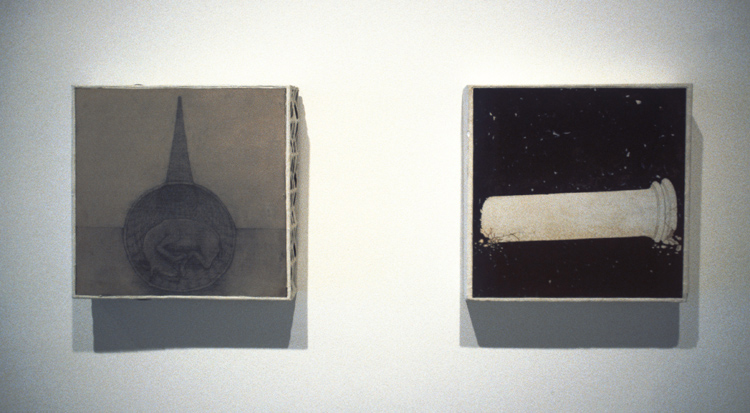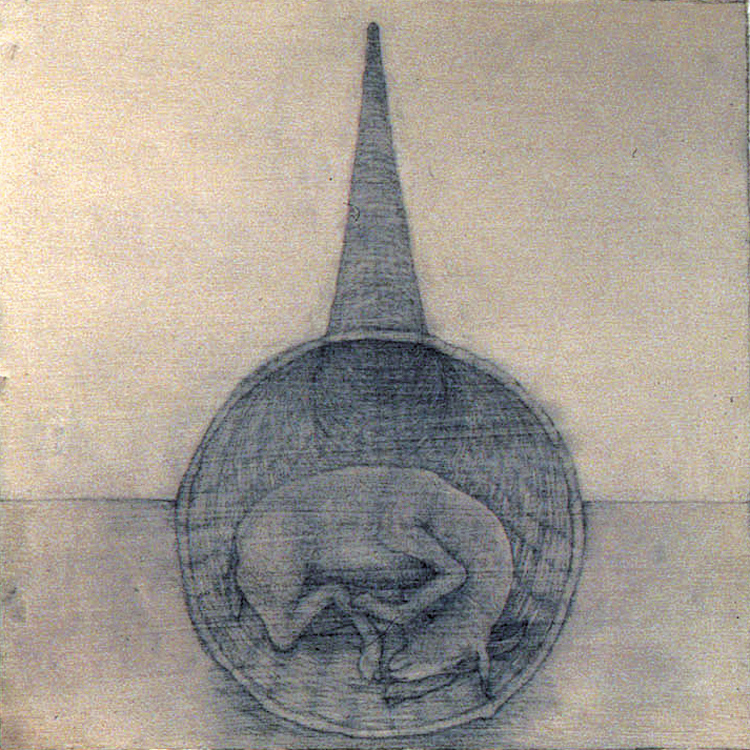
1989
(left)
graphite and modeling paste on wood panel
artist made frame with mahogany, banana tree fiber and drywall mud
19 x 19 1/4 x 4 inches
(right)
distressed porcelain enameled steel
artist made frame of plaster
18 7/8 x 19 1/4 x 4 inches
“The work below is Biographic Diptych. It is a drawing made in homage to what I learned while making it. The memory is clear of that crash and I rendered it clearly, etched in the porcelain steel. The companion piece is less distinct. It is a muddy drawing of a goat and cornucopia.
To get the blood, for The Extraction of Plenty, I went to a slaughterhouse on the edge of town where there was an illegal goat-butchering operation in progress. I had all my art material with me, my paintbrushes, my buckets and all the stuff required; but I was not prepared for the conditions I found. It was a horrific scene. The guy who was doing the slaughtering (and as I said, I have been a butcher, I have cut bologna and I am no stranger to the job) was torturing the animals on top of destroying them. I tried to make the art, the brushes useless around the steaming heaps of skin and flesh. I was inefficiently scooping the coagulating blood at my feet, placing it on the cornucopia. I just wanted to make the art and get out of there, away from this man. Then we looked at each other directly in the eyes; there was a for¬bidding sense of recognition and glee. He killed an animal, picked it up and threw it at the basket. It crashed into the piece and died within it. He started throwing them at me and I kept grabbing them and pouring their blood, their life, over the piece. We did it until the job was done and didn’t say a word. I walked away with the bloodied, woven cornucopia and I was incredibly, psychically disturbed. All my life I had thought I was a pacifist. I was making work about politics and all these good notions. Suddenly I couldn’t believe how delusional I had been. There I was, think¬ing, I am an artist and the reason I am the way I am is because I am alienated from society—and all the myths that go with that. At that moment, that Raymond Chandler “under the right circumstances you’ll do anything” moment, I was trans¬formed. I realized that I am common and thoroughly linked with the rest of ’em. That was a major understanding, that I am part of the rest of the world, common with the horror of the world, part of that same pain that I had critiqued. As I review the pol¬itics of our world, that critique is incomplete without self-examination, and that examination is not free from the mythology I have built around myself as an artist.”
-Mel Chin, from a lecture, “My Relation to Joseph Beuys is Overrated.” Printed in Mapping the Legacy, Gene Ray, ed., The John and Mabel Ringling Museum of Art, D.A.P., New York, NY, 2001

detail

detail